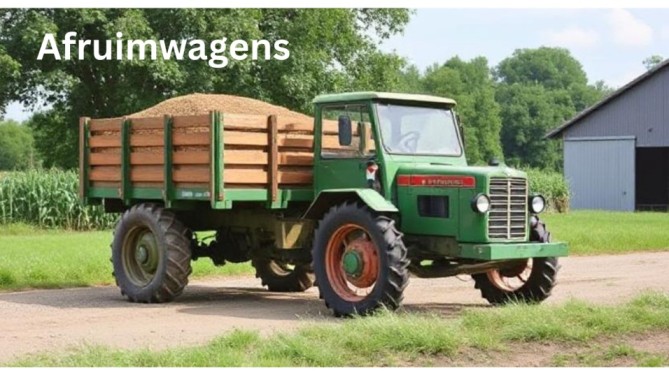Introduction
Afruimwagens, often recognized as essential transport and utility vehicles in agriculture and industry, represent a fascinating intersection of tradition and technological progress. While the term itself might sound highly specialized, afruimwagens are simply vehicles designed for collecting, transporting, and offloading goods, crops, or materials in an efficient manner. Over time, they have evolved from rudimentary, manually powered carts into advanced, mechanized machines capable of meeting the needs of modern operations.
The history and evolution of afruimwagens reflect broader changes in society, advances in engineering, shifts in agricultural practices, and the demand for faster, safer, and more sustainable systems of moving materials. This article explores the full journey of afruimwagens, analyzing the tradeoffs involved in different design approaches, the challenges faced across industries, and the lessons we can learn when making decisions about their use today and in the future.
Early Origins of Afruimwagens
The roots of afruimwagens can be traced back to simple carts and wagons used in farming communities centuries ago. Before industrialization, people relied on wooden carts pulled by animals to move harvested crops from fields to storage areas. These early versions served the same core function collecting and transporting but they were limited by:
- Manual labor and animal power
- Small load capacity
- Slow speeds
- Basic construction without protective features
Despite their limitations, these early afruimwagens laid the foundation for mechanization. Farmers quickly realized the importance of vehicles that could reduce time and labor, leading to innovations as tools and materials improved.
Industrial Revolution and Mechanization
The Industrial Revolution (18th–19th century) marked the first major transformation in the history of afruimwagens. Advances in metalworking, wheel design, and steam power introduced stronger, more durable wagons. Key developments included:
- Metal frames replacing wooden structures for better durability.
- Larger wheels and suspension systems that allowed heavier loads and smoother movement.
- The first experiments with steam-powered traction engines, which indirectly influenced the later motorized afruimwagens.
During this period, afruimwagens expanded beyond farming into construction, mining, and industrial logistics, reflecting the rising demand for efficient transport solutions in rapidly urbanizing societies.
The Motorized Era
By the early 20th century, the arrival of internal combustion engines brought a dramatic shift. Afruimwagens became motorized, which drastically improved:
- Speed and efficiency – Loads could be transported much faster than with animals.
- Capacity – Larger engines allowed bigger cargo loads.
- Accessibility – Farmers and companies could operate on uneven terrain without relying on animals.
This era also introduced specialization. Instead of a one-size-fits-all wagon, afruimwagens were tailored for different sectors:
- Agriculture: Grain carts, potato harvesters, and silage trailers.
- Construction: Dump-style afruimwagens for rubble and raw materials.
- Municipal services: Waste-collection afruimwagens for cities.
The tradeoff was cost: motorized afruimwagens required fuel, spare parts, and maintenance, which small farmers sometimes struggled to afford. Yet the long-term productivity gains outweighed these challenges, leading to widespread adoption.
Post-War Expansion and Technological Refinement
The mid-20th century brought mass production techniques and global economic recovery after World War II. Afruimwagens benefited from innovations in:
- Hydraulic systems for easier lifting and dumping.
- Improved tires and axles for better stability on rugged ground.
- Standardized designs that reduced manufacturing costs.
This period also highlighted tradeoffs:
- Durability vs. Affordability: Cheaper models were widely available but wore out faster.
- Specialization vs. Versatility: Farmers had to decide whether to invest in a general-purpose afruimwagen or a sector-specific design.
- Manual operation vs. Automation: Hydraulic-assisted unloading was faster but came at a higher price point.
These tradeoffs forced users to balance short-term budgets with long-term efficiency.
Modern Afruimwagens: Innovation and Diversity
Today, afruimwagens are diverse, technologically advanced, and highly specialized. Modern models incorporate:
- Lightweight materials like aluminum and composites to reduce fuel consumption.
- GPS and telematics for route optimization and fleet management.
- Ergonomic cabins that improve operator safety and comfort.
- Eco-friendly engines and even electric versions to meet sustainability goals.
They are now indispensable in:
- Agriculture – transporting harvested crops quickly to maintain freshness.
- Construction – handling massive volumes of sand, gravel, and stone.
- Municipal services – collecting and managing urban waste efficiently.
The tradeoffs in the modern era are often technological complexity vs. reliability. Highly advanced afruimwagens offer efficiency and data-driven decision-making but may be costly to repair, requiring skilled technicians and advanced spare parts.
Key Factors Driving the Evolution of Afruimwagens
Several overarching factors have shaped the history and continued development of afruimwagens:
- Agricultural Demands
- The need for faster crop collection and storage has driven innovation.
- Larger farms require bigger, more durable vehicles.
- Industrial Growth
- Expanding construction and mining projects created demand for heavy-duty afruimwagens.
- Technological Progress
- Engines, hydraulics, and automation have consistently pushed boundaries.
- Economic Tradeoffs
- High-tech models boost efficiency but require significant investment.
- Smaller operators must balance upfront cost against long-term value.
- Environmental Concerns
- The shift toward greener technologies affects design and adoption.
Challenges in Afruimwagen Development
Despite progress, afruimwagens face challenges that complicate their design and usage:
- Cost of Innovation: Advanced features like GPS and electrification are expensive, making adoption slower in developing regions.
- Maintenance Requirements: More technology means more potential points of failure.
- Fuel vs. Electric Debate: Traditional engines provide reliability, while electric models reduce emissions but have limited range and high initial costs.
- Standardization Issues: Different industries require unique specifications, making it difficult to create universally adaptable models.
- Environmental Regulations: Manufacturers must balance efficiency with strict emission laws.
Each challenge represents a tradeoff between immediate functionality and long-term sustainability.
The Future of Afruimwagens
Looking forward, afruimwagens are expected to evolve in several key directions:
- Electrification and Alternative Fuels
- Greater focus on electric or hybrid afruimwagens to meet carbon-reduction targets.
- Automation and Smart Systems
- Integration of self-driving technologies for agriculture and urban services.
- Modular Design
- Flexible configurations that allow one afruimwagen to serve multiple industries.
- Sustainability Focus
- Use of recyclable materials and energy-efficient systems.
- Data-Driven Efficiency
- IoT-enabled afruimwagens that provide real-time insights into performance, reducing downtime.
The balance between cost, performance, and sustainability will continue to shape the choices industries make.
Conclusion
The history and evolution of afruimwagens is a story of continuous adaptation. From simple wooden carts pulled by animals to today’s smart, eco-friendly machines, afruimwagens illustrate how technological progress meets practical necessity.
At every stage, tradeoffs have been central: durability vs. affordability, manual operation vs. automation, tradition vs. innovation. The challenges whether economic, technical, or environmental have forced manufacturers and users alike to make careful decisions.



